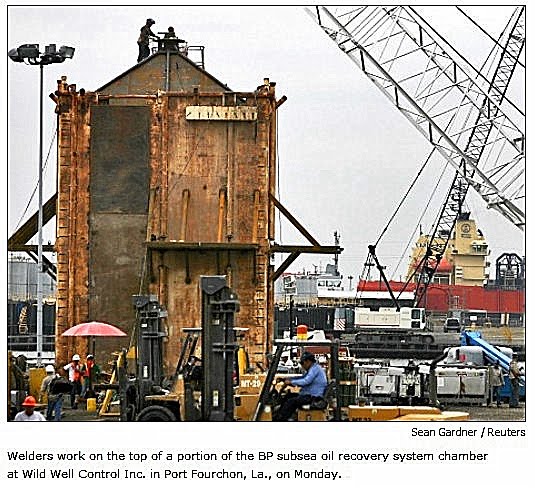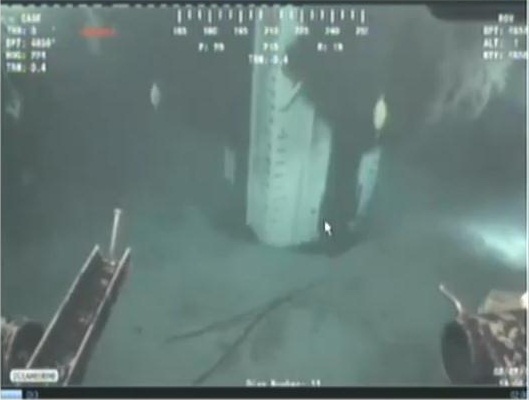BP Oil Spill: Case NOT Closed Posted on
October 19, 2012 by
WashingtonsBlog BP Says Everything Is Fine … Scientists Aren’t So SureToday, BP and the Coast Guard attributed the
new oil sheen to
a leak from the “cofferdam”.
We will give some background on what the cofferdam is, and then explain why the case is
not closed … and an ongoing investigation is needed to determine whether or not the well has really stopped leaking.
The Equipment Everyone Is DiscussingThe cofferdam is a container which BP tried to lower over the oil gusher in 2010.
Here is the way it was
supposed to work:


The cofferdam was built in Port Fourchon, Louisiana:


It was then shipped to the site of the spill and lowered into the ocean:





But it didn’t work. The cofferdam leaked, because
methane gushing out of the stricken well quickly built up, clogged up the cofferdam, and
made it float:


As FastCompany
summarizes:
<blockquote>BP’s … Cofferdam Operation, a 98-ton steel and concrete
containment chamber lowered on top of the damaged pipe that connected
the drilling rig to the oil well. The chamber took two weeks to build.
In theory, the 40-foot-tall chamber was supposed to capture oil and
allow it to flow through a pipe to a barge on the surface. But the Gulf
Oil Disaster Recovery Group reported on Saturday that the operation
failed–ice crystals formed inside the container, clogging the pipe that
was supposed to bring oil to the barge.
</blockquote>
After the cofferdam was lowered over the leak nearly a mile below the surface, it had to be raised and
moved 200 meters to the side. BP engineers then gave up on the cofferdam, tried the smaller “top hat” containment dome (which
also failed because it got
plugged up with methane hydrate crystals), and then moved onto the “junk shot” and “top kill” approaches to capping the well.
Any Oil from the Cofferdam Should Have Been Degraded By NowDr. Ian MacDonald – an expert in deep-ocean extreme communities
including natural hydrocarbon seeps, gas hydrates, and mud volcano
systems, a former long-time NOAA scientist, and a professor of
Biological Oceanography at Florida State University-
told us last week:
<blockquote>The key statement in the BP discussion was the fact that oil recovered on the ocean surface was not biodegraded. This is
not consistent with a pool of oil supposedly trapped in the wreckage of the riser
, which would have been exposed to ambient bacterial activity for over two years.
</blockquote>
When the cofferdam was moved, the oil would have mixed thoroughly
with sea water … and the oil-eating bacteria in it. Indeed, given the
large holes in the cofferdam shaped to fit the leaking riser pipes (as
shown in the photographs above), and the failure to maintain the the
cofferdam, it has most likely not been water tight for the last 2 years –
even sitting directly on the seafloor.
As such, Dr. MacDonald’s skepticism regarding BP’s explanations for recent oil sheen applies to BP’s new cofferdam theory.
And top oil spill expert Dr. Robert Bea – a UC Berkeley professor and government consultant – told us today:
<blockquote>With the information that has been released, I remain skeptical that they have found ‘the source’ for the continuing leak(s).
The cofferdam has a limited ‘supply’ … which has already been
exposed for a very long period of time to the seafloor environment … including several hurricanes. Thus, it is difficult to understand why it would start leaking recently … and continue to leak.
The search needs to be conducted like an archeological dig [using] a
close-spaced grid of multiple surveys employing different detection
equipment with accurate control of positions of the ‘sensors’.
When I worked for Shell on the Bay Marchand blowouts, we used
geophysical ‘sniffer’ equipment to trace the oil in the water
column….better than an ROV…..with the survey from the sea floor to the
surface… from Bay Marchand to the Bay of Campechee.
</blockquote>
A REAL, Thorough Investigation of the Seafloor Is A Vital Matter for AmericaBea has
repeatedly stated that BP’s oil disaster could very well have enlarged nearby oil
seeps or even fractured the seabed, allowing a path for oil to make it
into the ocean (and
see this).
Another expert
warned right after the well was capped in 2010 that capping the well could have unintended consequences:
<blockquote>Bill Gale, a California engineer and industrial explosion
expert who is a member of the Deepwater Horizon Study Group [formerly
Chief Loss Prevention Engineer for Bechtel in San Francisco], said… that
gas hydrate crystals could be plugging any holes in the underground portion of the well, and they
could get dislodged as pressure builds.
</blockquote>
In other words, there may have been a destruction of a portion of the
steel well casing which was temporarily plugged by methane crystals.
Leaving the well cap may slowly raise the pressure in the well to the
point where the hydrate crystals are dislodged, in which case the well
might really start leaking.
Although even less likely, scientists say that the methane could disturb the seafloor itself. As the St. Peterburg Times
points out:
<blockquote>Disturbing those [methane hydrate] deposits — say, by
drilling an oil well through them — can turn that solid methane into a
liquid, leaving the ocean floor unstable, explained [Carol Lutken of the
University of Mississippi, which is part of a consortium with SRI which
has been conducting methane research in the Gulf of Mexico for years].
***
Generally the oil industry tries to avoid methane areas during drilling for safety reasons.
</blockquote>
No wonder Congressmen Markey and Waxman have
demanded that BP survey the seafloor near the site of the leaking oil well to determine whether there is new damage.But BP has – apparently – refused to comply with their demand.
Because BP is
struggling to wrap up a favorable settlement of lawsuits against it, the company is very motivated to sweep any problems under the rug.
Source:-
http://www.washingtonsblog.com/2012/10/bp-oil-spill-case-not-closed.html 